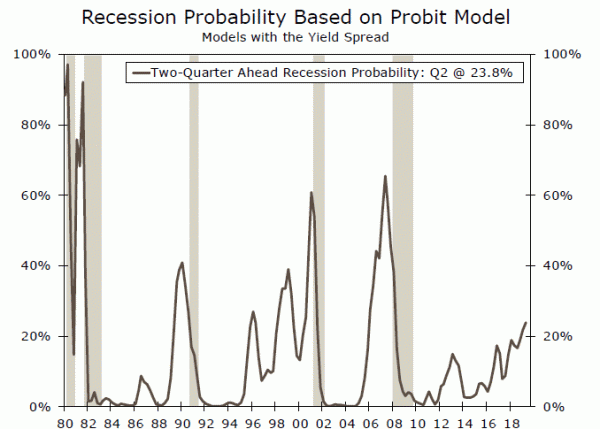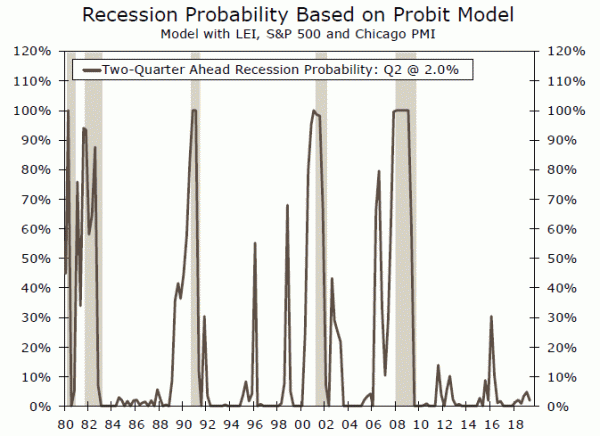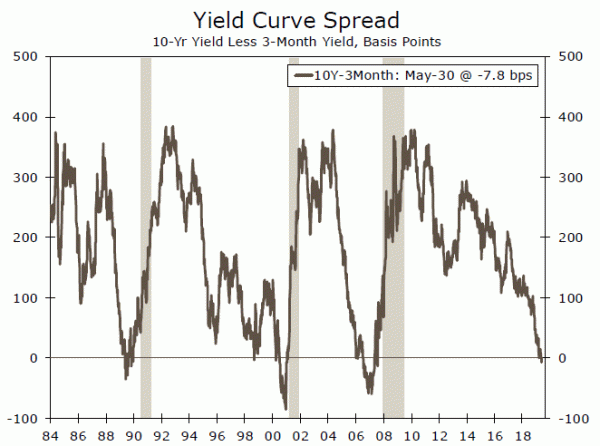The recent inversion of the yield curve has elevated investors’ interest in the risk of a recession. However, our models indicate a low probability that a recession will occur within the next six months.
Inverted Yield Curve and Recession: Mirage or Reality?
The recent inversion of the yield curve has brought heightened market sensitivity to an imminent recession and caused analysts to question the yield curve as a reliable recession indicator. As we have previously discussed, the depth and duration of the inversion is important to predict an imminent recession.1 For example, before the last two recessions, the spread of the 10-year note over the 3-month bill fell to as little as -60 bps in early 2007 and to nearly -100 bps in late 2000. The yield curve remained in negative territory for several consecutive months prior to the last three recessions (top chart). While the curve stayed above the zero line in April, in late March the spread slipped into the negative zone for the first time in the post-Great Recession era, and fell to -12 bps on May 29. Compared to historical standards, the current inversion is very shallow, and the depth and duration do not indicate a recession in the near-term. In our opinion, the yield curve would need to invert significantly and for a longer duration to be a reliable recession signal. Furthermore, the Federal Reserve’s quantitative easing (QE) program may have affected the yield curve, depressing longer-term yields and making the curve more inverted than it may otherwise be. Essentially, because of the QE purchases, the yield curve needs to invert even further than it did in the past and stay there for longer before we would feel more confident in making a recession call.
Recession Probability Models
Our official Probit model estimates the probability of a recession during the next six months. We built the model in 2007 and over the past 12 years it has helped us to accurately predict recessionary periods. Using data through April 2019, our model suggests a meager 2.0% chance of a recession in the shortrun (middle chart).2
Our Probit model that uses the yield curve as a predictor estimates a 23.8% probability of a recession during the next six months. Although elevated (highest in the post-Great Recession era), the probability of a recession remains below previous thresholds associated with a recession (bottom chart). The model predicted a 55% probability in Q1-2007 and a 61% probability in Q1-2001.
The recent inversion of the yield curve is interesting but it is the only indicator in our model that is suggesting trouble may be lurking around the corner. The index of Leading Indicators (LEI) is healthy, with the average monthly growth rate at 0.16% this year. The stock market remains generally supported and employment growth is positive. Acknowledging downside risks to the outlook, we would need to see a further sustained inversion of the curve, along with a generalized restriction in financial market conditions and deterioration in the economic fundamentals to become more worried about the sustainability of the economic expansion.
1 See “Inverted Yield Curve: Is It Different This Time?” (March 26, 2019).
2 See “Recession Update: Should We Worry?” (April 01, 2019).















